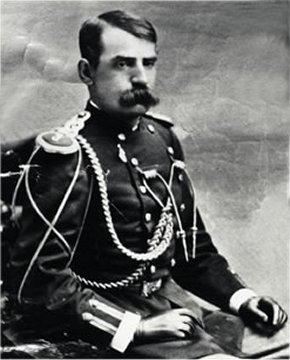 Of
the several books Edgar Rice Burroughs consulted in his research on Apaches,
one bore the rather cumbersome and dry sounding title:
Ninth Annual
Report of the Bureau of Ethnology to the Secretary of the Smithsonian Institution
1887-'88. This five-pound plus tome (first published in 1892)
was part of an ongoing set of matched volumes bound in dark brown cloth,
with gilt spine lettering, bearing the imprint of the Government Printing
Office, Washington, D.C.
Of
the several books Edgar Rice Burroughs consulted in his research on Apaches,
one bore the rather cumbersome and dry sounding title:
Ninth Annual
Report of the Bureau of Ethnology to the Secretary of the Smithsonian Institution
1887-'88. This five-pound plus tome (first published in 1892)
was part of an ongoing set of matched volumes bound in dark brown cloth,
with gilt spine lettering, bearing the imprint of the Government Printing
Office, Washington, D.C.
The 1892 first edition contained two papers. The first,
and longest was a 442 page treatise on the Point Barrow Eskimo by John
Murdock. The second contribution (original pages 443-603) was a fascinating
study entitled
The Medicine Men of the Apache by John G. Bourke,
Captain, Third Cavalry, U.S. Army. Bourke (pronounced "Burrk") was the
author of the earlier ethnological works: The Snake Dance of the Moguis
(Hopi) of Arizona
(1884), and
Scatalogic Rites of All Nations (1891).
He also penned the classic military histories: An Apache CAmpaign
in the Sierra Madre (1886), and On the Border with Crook (1891).
Bourke's 160 page monograph on Apache medicine men, as
it appeared in the Ninth Annual Report of the Bureau of Ethnology,
provided a cornucopia of ethnographic information to novelist, and former
Seventh Cavalry trooper, Edgar Rice Burroughs. Within its pages ERB found
vivid descriptions of Apache medicine men performing various sacred ceremonies
as observed by Bourke during his many years of duty as an army officer
in Apacheria. These included healing ceremonies for all mode of ills, and
the cha-ja-la or "Spirit" dance in which the dancers personify the
Kan or Mountain spirits. Bourke witnessed this most sacred of Apache
ceremonies on several occasions.
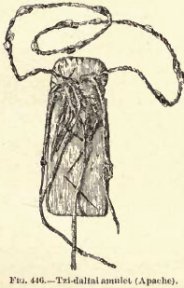
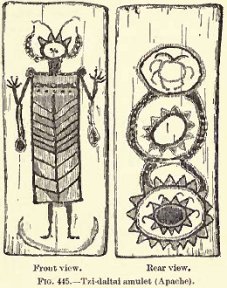
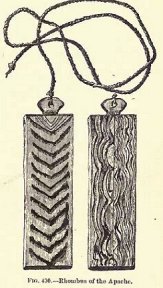
Therein also, ERB found descriptions and illustrations
of the rhombus or tzi-ditindi; the sacred amulet tzi-daltai;
the izzekloth or medicine cord; the scratch stick and drinking reed;
and bags containing
hoddentin, the sacred pollen of the Apache.
Bourke introduced his readers to three Western Apache medicine men: Na-a-cha,
Nakay-do-klunni and Nan-to-do-tash -- two of whom make fictional appearances
in The War Chief/Apache Devil. All of the above elements and more,
the Wizard of Tarzana transported in his own artful way from the pages
of the ninth Annual Report to the pages of his Apache epic. Nearly
half of the terms ERB listed in his thirty-five word Apache glossary at
the back of The War Chief were discovered in Bourke's monograph.
John G. Bourke was one of the last of the nineteenth century
"soldier scientists" whose ranks provided the government with detailed
information about the native inhabitants, geography, and flora and fauna
of an expanding frontier. Named for Saint John and for Gregory, the patron
saint of learning, Bourke was born in Philadelphia in 1846 to Irish Catholic
immigrant parents. At age eight Bourke was studying Greek, Latin and Gaelic
under a Jesuit tutor.
At sixteen Bourke embarked on a military career that would
have fulfilled the fondest daydreams of Edgar Rice Burroughs. Caught up
in the furor of the Civil War, he joined the Fifteenth Pennsylvania Volunteer
Cavalry in 1862. Bourke won the Medal of Honor for "GAllantry in action"
at the Battle of Stones River, Tennessee. He was with the first Union troops
to arrive in Atlanta under William Tecumseh Sherman.
After the Civil War Bourke received an appointment to
West Point. In 1869 he was commissioned as a second lieutenant in the Third
Cavalry and ordered to the Southwest where he soon became embroiled in
the Apache Wars. In 1871 he was named aide-de-camp to Major General George
Crook, commander of the MIlitary Department of Arizona. Bourke was with
Crook during the Sioux Indian Campaign of 1876, and throughout the Apache
conflicts of the early 1870s and 1880s.
Since his first arrival in the West Bourke kept a steady
diary. Curious and observant, he was constantly making field notes on the
customs, behaviour, beliefs, language and material culture of indigenous
peoples. Bourke studied many tribes but it was the Western Apache of Arizona
that he came to know the est. His dual projects became the compilation
of an Apache dictionary and grammar and a study of Apache medicine men.
Because of his seemingly endless writing, one Apache chief inquired whether
Bourke wa
naltsus-bichidin or "paper medicine man." IN The Medicine
Men of the Apache (pg. 500) Bourke explained: "I made it a touchstone
of friendship that every scout or other Apache who wished for a favor at
my hands should relate something concerning his religious belief. I did
not care much what topic he selected; it might be myths, war customs, clan
laws, medicine -- anything he pleased, but it had to be something and it
had to be accurate."
The Medicine Men of the Apache contains three chapters.
Chapter I, titled "The Medicine-men, Their Modes of Treating Disease, Their
Superstitions, Paraphernalia, etc." includes descriptions and explanations
of the rhomus or tzi-ditindi (sounding wood) used to imitate the
sound of a gust of rain-laden wind; the cross, which symbolizes the cardinal
points and four winds; and the scratch stick and drinking reed used by
novice warriors on their first four raids. ERB made much use of the ethnographic
information in this chapter as exemplified by his skillful description
of the latter two objects in The War Chief (pg. 148, 149). "Having
eaten, Shoz-Dijiji quenched his thirst from his water bottle, drawing the
liquid into his mouth through his drinking reed, a bit of cane, attached
to his scanty apparel by a length of buckskin, for no water might touch
his lips during his four novitiate excursions upon the war trail. "Treasured
therefore was his sacred drinking reed without which he must choose between
death by thirst and the loss of credit for all that he had performed upon
the war trail, together with the attendant ridicule of the tribe.
"Only slightly less esteemed was another treasure dangling
from a second buckskin thong - a bit of cedar three inches in length and
less than half an inch in width. This was his scratch stick, an article
that he found constant use for, since he might not scratch himself with
his fingers during this holy period of initiation into the rites and mysteries
of the sacred war trail. These two necessary adjuncts to the successful
consummation of his ambition he had fashioned in the high places under
the yes of Usen; he had sanctified them with prayer and the sacrificial
offering of hoddentin and he had brought them to Nakay-do-klunni, the great
izze-nantan, to be blessed, and so he set great store by them. . . ."
Chapter I of The Medicine Men of the Apache contains
an interesting discussion of the use of "gibberish" words and incantations
by Apache healers. Bourke reported that "When a man is taken sick
the medicine-men are in the zenith of their glory . . . and all bodily
disorders and ailments are attributed to the maleficence of spirits who
must be expelled or placated." Describing a typical Apache healing ceremony
Bourke wrote: "The medicine-men lead off in the singing, to which the assistants
reply with a refrain which at time has appeared to me to be antiphonal.
Then the chorus is swelled by the voices of the women and larger children
and rises and falls with monotonous cadence. Prayers are recited . . .
but very frequently the words are ejaculatory and confined to such expressions
as 'ugashe' (go away), and again there is to be noted the same mumbling
of incoherent phrases which has been the stock in trade of medicinemen
in all ages and places. This use of gibberish was admitted by the medicine-men,
who claimed that the words employed and known only to themselves (each
individual seemed to have his own vocabulary) were mysteriously effective
in dispelling sickness of any kind."
Burroughs describes the Apache medicine men Nan-to-do-tash
and Nakay-do-klunni often mumbling or chanting "weird gibberish." That
is nothing new for ERB who, throughout his writings, tends to portray witch
doctors, medicine men and various priestly types as gibberish-spouting
hypocrites or fanatics whose overall influence on their flock is detrimental.
Bourke too believed that all medicine men (and medicine women) were essentially
charlatans. But of the Apache he observed: "It must be conceded that the
monotonous intonation of the medicine-men is not without good results,
especially in such ailments as can be benefited by the sleep which such
singing induces." If ERB did not read The Medicine Men of the Apache
until 1926, he found in its pages a powerful reinforcement of his own long-held
notions regarding the methods and motives of tribal healers and religious
leaders. If he consulted the Ninth Annual Report at a much
earlier date, then Bourke's paper could have contributed to the formation
of Burroughs' ideas.
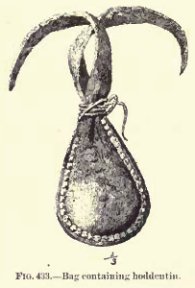
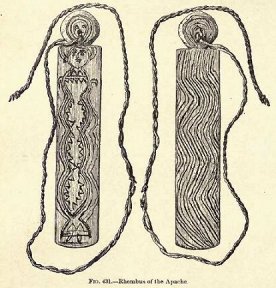
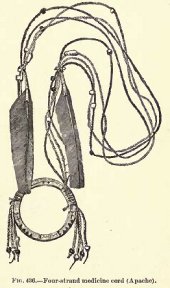
Chapter II of The Medicine Men of the Apache is
entitled: "Hoddentin, the Pollen of the Tule, the Sacrificial Powder
of the Apache; With Remarks Upon Sacred Powders and Bread Offerings in
General." This chapter opens with a detailed look at the many Apache uses
for hoddentin, its origin, and significance to Apache religion.
Wrote Bourke: "One of the first things to be noticed among the Apache .
. . was the very general appearance of little bags of buckskin , sometimes
ornamented, sometimes plain, which were ordinarily attached to the belts
of the warriors, and of which they seemed to be especially careful. . .
The bags spoken of revealed when opened a quantity of yellow colored flour
or powder, resembling cornmeal, to which the Apache gave the name of 'hoddentin'
or 'hadntin,' the meaning of which word is 'the powder or pollen of the
tule,' a variety of the cat-tail rush, growing in all the little ponds
and cienegas of the Southwest.
Bourke reported that Apaches offered pinches of hoddentin
to the four directions and four winds; to the sun and moon; to dawn and
darkness; to fire; and often to the morning star; and to na-u-kuzze,
the Great Bear. Hoddentin was employed in healing ceremonies, puberty
rites and funerals. IN Apache mythology, Bourke noted, Assanut-li-je
(Changing Woman) spilled hoddentin across the night sky and thus
created the Milky Way.
Burroughs sprinkled many images of hoddentin usage
throughout his Apache epic. When Cochise lay dying in Chapter III of The
War Chief ERB described the healing ceremony (pg. 51). "They sat in
a circle about a large fire beside which lay Cochise, Nakay-do-klunni and
Nan-to-do-task, wearing the sacred izze-kloth and elaborate medicine headdress,
danced in a circle about the sick man and the fires. . . . Now Nan-to-do-task
advanced toward Cochise and sprinkled hoddentin upon his arms and legs
in the form of a cross and as he backed away to resume the dancing Nakay-doklunni
took his place beside the dying chieftain and made similarly the mystic
symbol upon his head and breast." In Chapter II of The Medicine Men
of the Apache (pg. 502) Bourke wrote: "When a person is very sick the
Apache make a great fire, place the patient near it, and dance in a circle
around him and the fire, at the same time singing and sprinkling him with
hoddentin in the form of a cross on head, breast, arms and legs."
In The War Chief (pg. 70, 71) ERB describes Shoz-Dijiji
making preparations for his first adventure on the war path. "From a buckskin
bag upon which Morning Star had sewn pretty heads the boy took a still
smaller bag containing hoddentin, a pinch of which he sprinkled on each
side of the tzi-daltai, and then he tossed a pinch out over the cliff in
front of him and one over his left shoulder and one over his right and
fourth behind him. 'Be good, O, winds!' he prayed. Another pinch of hoddentin
he tossed high in air above him. 'Be good, O, ittindi! Make strong the
medicine of Shoz-Dijiji that it may protect him from the weapons
of his enemies."
In Chapter VI of The War Chief (pg. 110) ERB describes
Ish-kay-nay's womanhood ceremony. "The drums boomed, the dancers bent double,
whirled about first upon one foot and then upon the other. The men advanced,
the girls retreated to the outer edge of the dance ground. Among them,
grotesque, painted, decked out in the finery of their most gorgeous medicine
headdress, their finest izze-kloths, whirling their tzi-ditindes, the izz-nantans
whirled and leaped and danced, sprinkling the sacred hoddentin upon the
youths and maidens."
And in Chapter Three of Apache Devil (pg. 54) ERB
writes: "At a little distance a warrior cast hoddentin into the air and
prayed: "Guin-ju-le, chil-jilt, si-chi-zi, gun-ju-le, inzayu, ijanale,'
-- 'Be good O Night; Twilight, be good; do not let me die.'" These Apache
words and phrases ERB found in Chapter II of The Medicine Men of the
Apache.
In the same chapter, Bourke included a single brief paragraph
concerning the Cibeque Apache holy man Nakay-do-klunni, which proved to
be of great use to Burroughs. On page 505 Bourke wrote: "The Apache medicine-man,
Nakay-do-klunni, called by the whites 'Bobbydoklinny,' exercised great
influence over his people at Camp Apache, in 1881. He boasted of his power
to raise the dead, and predicted that the whites should soon be driven
from t eh land. He also drilled the savages in a peculiar dance, the like
of which had never been seen among them. The participants, men and women,
arranged themselves in files, facing a common center, like the spokes of
a wheel, and while thus dancing hoddentin was thrown upon them in profusion.
This prophet or 'doctor' was killed in the engagement in Cibicu canyon,
August 30, 1881."
Burroughs used the Cibeque (pronounced "Sibeque") incident
as a key turning point in the plot of The War Chief. His characterization
of Nakay-do-klunni as evil, self-serving, and destructive to his own people
was doubtless a combination of his own thinking, together with Bourke's
conclusions regarding medicine men in general. ERB later added more details
to his description of the Cibeque affair, gleaned from Anton Mazzanovich's
Trailing
Geronimo (1926). Both Bourke and Mazzanovich presented Nakay-do-klunni
and the circumstances which led to the Cibeque confrontation from the white-military
perspective. From the Apaches' point of view, all they were doing was dancing.
The balance of Chapter II of The Medicine Men of the
Apache is given over to Bourke's numerous analogies to hoddentin
and similar uses of sacred pollen, meal, powder, breads and cakes from
cultures of all historical periods worldwide. Included are references
to the practices of ancient Greeks, Romans, Egyptians, Hebrews, Hindus,
Africans, Australians, Aztecs, Peruvians and Zuni. This penchant for comparison
is evident throughout Bourke's paper, so much so that only about one third
of The Medicine Men of the Apache is actually about Apaches or their
religion. Bourke also laced his text with frequent quotes in French, Spanish
and Latin from many sources, some of which he translates, others not. For
these reasons some readers might find parts of Bourke's monograph to be
as dry as some of the sacred powders and bread offerings discussed in Chapter
II.
Chapter III of The Medicine Men of the Apache is
titled: "The Izze-kloth or Medicine Cord of the Apache." Here Bourke describes
in detail several different Apache medicine cords containing two, three
or four strands. He notes of these cords: "There is probably no more mysterious
or interesting portion of the religious or 'medicinal' equipment of the
Apache Indian, whether he be medicine-man or simply member of the
laity, than the 'izzekloth' or medicine cord, illustrations of which accompany
this text . . . the Apaches look upon these cords as so sacred that strangers
are not allowed to see them, much less handle them or talk about them."
Bourke further noted: "These cords will protect a man while on the warpath,
and many of the Apache believe firmly that a bullet will have no effect
upon the warrior wearing one of them . . . the wearer can tell who has
stolen ponies or other property from him or from his friends, can help
the crops, and cure the sick."
Burroughs, in Chapter One of Apache Devil (pg.
10), portrays in rich detail Nan-to-do-tash leading an Apache ceremonial
dance. "The old men beat upon the es-a-da-ded, the primitive drum of buckskin
stretched across a hoop; and to their cadence Nan-to-do-tash led the dancers,
his body painted a greenish brown with a yellow snake upon each arm; upon
his breast, in yellow, a bear; and upon his back the zig-zag lines of lightning.
"His sacred izze-kloth, passing across his right shoulder,
fell over his left hip. Of a potency almost equal to this four strand medicine
cord of twisted antelope skin was the buckskin medicine hat of Nan-to-do-task
by means of which he was able to peer into the future, to foresee the approach
of an enemy, cure the sick, or tell who had stolen ponies from other people.
"The downy feathers and black-tipped plumes of the eagle
added to the efficacy and decoration of this potent head-dress, the value
of which was further enhanced by pieces of abalone shell, by duklij, and
a snake's rattle which surmounted the apex, while in brownish yellow and
dirty blue there were depicted upon the body of the had clouds, a rainbow,
hail, the morning star, the God of Wind, with his lungs, the black Kan,
and the great suns." All of the details concerning body decorations, the
izze-kloth and Nan-todo-tash's sacred medicine had were found by ERB in
Chapter III of The Medicine Men of the Apache.
Bourke also described the Apache amulet tzi-daltai
made from a piece of lightning-riven wood and worn by both men and women.
Burroughs depicts Shoz-Dijiji making his tzi-daltai in preparation
for warrior training in Chapter IV of The War Chief (pg. 70) based
on Bourke's information. "For an hour, he worked unceasingly until the
splinter, smoothed upon its two flat sides, suggested, roughly, the figure
of a short legged, armless man . . . . Upon one flat side he carved zigzag
lines -- two of them running parallel and longitudinally. These represented
ittindi, the lightning. Upon the opposite side he cut two crosses and these
he called intchi-dijin, the black wind . . . Thus did Shoz-Dijiji, the
Black Bear, fashion his tzi-daltai."
The last items to be dealt with in Chapter III of Bourke's
monograph are Apache medicine shirts, medicine sashes, and phylacteries
or medicine bundles. The latter object is a small piece of buckskin (or
other material) inscribed with religious symbols, often used to wrap other
sacred objects, and worn secreted 'from the view of others.' Bourke described
the contents of the Tonto Apache medicine man Na-a-ch's phylactery on page
592. "It . . . unwrapped a tiny bag of hoddentin, which in its turn, held
a small but very clear crystal of quartz and four feathers of eagle down.
Na-a-cha took care to explain very earnestly that this phylactery contained
not merely the 'medicine' or power of the crystal, the hoddentin, and the
itza-chu, or eagle, but also of the shoz-dijiji, or black bear, the shoz-lekay,
or white bear, the shoz-litzogue, or yellow bear, and the klij-litzogue,
or yellow snake, though just in what manner he could not explain." Thus,
from the symbols found within the Apache medicine man's sacred phylactery,
examined by Bourke, Edgar Rice Burroughs discovered the term shoz-dijiji,
which he used to name his "Apache Tarzan."
Bourke concluded his monograph with the following statement,
which Burroughs certainly read: "It will only be after we have thoroughly
routed the medicine-men from their entrenchments and made them an object
of ridicule that we can hope to bend and train the mind of our Indian wards
in the direction of civilization. In my own opinion, the reduction of the
medicine-men will effect more for the savages than the giving of land in
severalty or instruction in the schools at Carlisle or Hampton; rather,
the latter should be conducted with this great object mainly in view: to
let pupils insensibly absorb such knowledge as may soonest and mot completely
convince them of the impotency of the charlatans who hold the tribes in
bondage.
"Teach the scholars at Carlisle and Hampton some of the
wonders of electricity, magnetism, chemistry, the spectroscope, magic lantern,
ventriloquism, music, and then, when they return to their own people, each
will despise the fraud of the medicinemen and be a focus of growing antagonism
to their pretensions . . . impress upon each one that he is to return as
a missionary of civilization. Let them see that the world is free to the
civilized, that law is liberty."
Bourke and his fellow ethnologists believed that all human
societies progressed in stages from a state of "rudeness" or "savagery"
to civilization -- the highest state of civilization being then represented
by European and American society. Burroughs expended much ink deriding
the benefits of civilization in The War Chief and Apache Devil,
as he does in his Tarzan novels, and elsewhere. Ironically, Bourke's
own beliefs regarding the benefits of civilization would, late in his life,
come to dovetail with those expressed by Burroughs.
Although Bourke disparaged their medicine men, he recognized
that the Apaches possessed a rich cultural heritage of their own. He saw
in many of them such finer qualities as truthfulness, honour, chastity,
intelligence, industry and valor; which he often perceived as lacking among
the representatives of his own culture in the Southwest. When the Chiricahua
Apaches were imprisoned in Florida under less than humane conditions, Bourke
became deeply involved in the struggle for their welfare. This struggle
brought him into conflict with powerful forces within the military / political
establishment. Bourke blamed General Nelson A. Miles for the plight of
the imprisoned Apaches and the betrayal of loyal Apache scouts. He faulted
the government for the cruelty and stupidity of its Indian policy.
While visiting the captive Chiricahuas at Fort Marion,
St. Augustine, Florida, in 1887 (an experience that profoundly depressed
him) Bourke wrote in his diary: ". . . the legend 'it is finished' was
written at the end of the unbroken series of plunder and exaction marking
the progress Westward of Caucasion civilization; the last feeble remnant
of savagery, fighting with the courage of despair to defend its barren,
mountain birthright had been ground into powder beneath the heel of a nation
whose proud boast had been 'Liberty to all the land and to all the inhabitants
thereof.'"
Besides the Ninth Annual Report, Burroughs also
read and used small but important parts of Bourke's magnum opus On the
Border With Crook whether or not he ever held a copy in his hands.
That is because historian Norman B. Wood, author of Lives of Famous
Indian Chiefs (1906), transcribed several long passages from On
the Border with Crook in his biographical sketch of Geronimo. Lives
of Famous Indian Chiefs is one of ten books ERB listed in his work
sheets as having consulted while researching Apaches.
From On the Border with Crook, by way of Lives
of Famous Indian Chiefs, ERB was able to reconstruct the famous conference
held between Geronimo and General George crook in March, 1886, at Canyon
de los Embudos (Canyon of the Funnels), Sonora, Mexico. Bourke was at CRook's
side at that ill-fated summit and recorded, near verbatim, both Geronimo's
memorable creation and Crook's grim ultimatum. Burroughs, in turn, incorporated
Crook's and Geronimo's words into his historically accurate Chapter Eight
of Apache Devil.
Also in On the Border With Crook (via Lives
of Famous Indian Chiefs), Burroughs found Bourke's lacerating indictment
of a whiskey peddling low-life named Tribollet. It was Tribollet who, with
whiskey and lives, undermined the March 1886, surrender of Geronimo's band
of Chiricahua Apaches to General Crook. Tribollet ws probably associated
with the "Tucson ring," an under-class of crooked Indian agents, government
contractors and contraband runners who sought to prolong the Apache wars.
Bourke called them "wicked men, whose only mode of livelihood was from
eh vices, weaknesses, or perils of the human race." Of Tribollet Bourke
wrote: "What did Tribollet care how many settlers' homes were burned, their
stock driven off, and their families butchered, if he could only sell his
vile adulterated whisky at 'ten dollars a gallon in silver.'"
ERB used the Tribollet incident, as recorded by Bourke,
for the basis of Chapter Nine of Apache Devil titled, appropriately,
"Red Fools and White Scoundrels." In this chapter (pg. 147) ERB wrote:
"Many of the braves already felt the effects of the adulterated, raw spirits
that Tribollet ws selling them at ten dollars a gallon, and most of those
that had been drinking were daubing their faces with war paint and boasting
of what they would do to the soldiers of the pindah-lickoyee." Burroughs
echoed Bourke and gave Tribollet his due at the conclusion of Chapter Nine,
writing: ". . . Geronimo rode silently out through the night with these
and eighteen other warriors, fourteen women, and two boys, down into the
mountains of Mexico; and the results of months of the hardest campaign
that possibly, any troops in the history of warfare ever experienced were
entirely nullified by one cheap white man with a barrel of cheap whiskey."
It is likely that Bourke's harsh indictment of Tribollet and his ilk provided
at least some inspiration for ERB's fictional archetype of frontier Anglo
evil, "Dirty" Cheetim. Of course, Burroughs might have observed a "Dirty"
Cheetim-type or two in the flesh during the time he spent in Arizona Territory
in the 1890s.
The question remains, did Burroughs read all of On
the Border With Crook or at least the chapters that dealt with Apache
wars? ERB attended the Michigan Military Academy in the 1890s. The Academy
would have had a library. On the Border With Crook would probably
have been in that library. It is just the sort of book that a young Edgar
Rice Burroughs, filled with visions of military glory, would have perused
with relish. Phil Burger, in his article on John Cremony's Life Among
the Apaches (The Burroughs Bulletin, New Series #31), pointed out several
similarities between elements found in On the Border With Crook
and some of ERB's writings. One of these was Bourke's mention of certain
caves with "peculiar medicine qualities, which would prevent an enemy from
gaining possession of it." Such medicine caves are reminiscent of the strange
cave that John Carter discovered in his flight from hostile Apaches in
Chapter One of
A Princess of Mars.
There is another parallel that can be noted between On
the Border With Crook and A Princess of Mars. That is the striking
resemblance between the real-life First Lieutenant Howard Bass Cushing
and ERB's second most famous fictional hero, Captain John Carter. Bourke
served as Lt. Cushing's junior officer in Troop F, Third Cavalry in 1870-'71.
Cushing was a relentless Indian fighter and led Troop F, Bourke accompanying,
on numerous scouts after hostile Apaches. Cushing commanded during Bourke's
first action against Apaches in 1870 and he became Bourke's mentor and
friend.
The story of Howard Bass Cushing is interwoven into the
first several chapters of On the Border With Crook. Many of the
details sound suspiciously similar to ERB's portrayal of John Carter in
Arizona. Like John Carter, Howard Bass Cushing was an army officer who
had fought in the Civil War (albeit on the side of the North). John Carter
went west after the War of Rebellion, landing in Arizona Territory. Cushing
was ordered to the Southwest by the army, arriving first in New Mexico
and later in Arizona Territory. Cushing and Carter were both professional
soldiers. Carter had a desperate encounter with hostile Apaches. Cushing
and his troop had many bloody encounters with Apaches.
In the foreword to A Princess of Mars Burroughs
describes John Carter's eyes as being ". . . of a steel grey, reflecting
a strong and loyal character, filled with fire and initiative." And in
his foreword to The Gods of Mars Burroughs wrote of Carter: "His
keen grey eyes were undimmed, and the only lines upon his face were the
lines of iron character and determination, coolness, and energy which had
made his name famous all over the southwestern border."
In the foreword to A Princess of Mars ERB reveals
that John Carter "had been prospecting and mining in Arizona part of the
time since the war . . ." Captain Carter related in his manuscript that
he and his partner Powell had located a "remarkable gold bearing quartz
vein" from which they extracted "over a million dollars worth of ore."
Bourke describes in On the Border With Crook (pg. 98) how he, Cushing,
and Troop F (with stories of lost Spanish mines "ringing in our ears")
searched out an opened a long abandoned silver mine at the urging of one
of their Mexican guides. Ore was removed and sent to San Francisco to be
assayed but with disappointing results. Bourke further related of his experiences
with Cushing and Troop F. "We were among the very first to come upon the
rich ledges of copper which have since furnished the mainstay to the prosperity
of the town of Clifton, on the border of New Mexico, and we knocked off
pieces of pure metal, and brought them back to Tucson to show the people
there.
For John Carter, cowardice was not an option. In times
of danger CArter acted "more upon impulse than after mature deliberation."
Cushing too was renowned for his absolute courage. Bourke, who was no coward,
considered Cushing to be the bravest man he ever knew. But, as Bourke illustrated
in On the Border With Crook, Cushing could be less than prudent
in that he had a tendency to want to rush into every fray, ignoring the
advice of his scouts. In fact, Cushing was impulsive (a la John Carter)
at times to the point of recklessness. This combination of personality
traits probably contributed to his early demise. Howard Bass Cushing was
32 years old when he was killed in an Apache ambush in Arizona Territory
in 1871.
There is one more important way that Bourke may have indirectly
influenced Burroughs. ERB based his negative characterization of the Ned-ni
Apache chief Juh in The War Chief upon a few remarks he found in
Charles F. Lummis' Southwest classic The Land of Poco Tiempo (1893).
Lummis met Bourke at Fort Bowie, Arizona Territory in 1886 when he was
reporting on the Geronimo campaign for the Los Angeles Times. Bourke
befriended Lummis and supplied the newspaperman with a wealth of details
about the GEronimo campaign, various individuals involved, and Apaches
in general. Lummis later used much of this same information in his book.
Bourke (who never met Juh) was probably Lummis' source for the image of
Juh as a "butcher" -- a label that reflected the white-military point of
view toward an elusive Apache chief who the army never understood nor ever
conquered.
Bourke and Burroughs both worked at the World's Columbian
Exposition in Chicago in 1893. Bourke was on detail as curator of a Department
of State exhibit called La Rabida which displayed important historical
documents and artifacts related to the European discovery and exploration
of the New World. A teen-aged Burroughs drove a battery powered electric
automobile around the fairgrounds to advertise his father's American Battery
Company. Perhaps Bourke, in his comings and goings, would have noticed
so strange a sight as an "electrical horseless carriage" maneuvering around
the fairgrounds. Perhaps, also, ERB found time to visit La Rabida
to view such treasures as Queen Isabella's crown, an autograph signature
of Hernando Cortez, and Walter Raleigh's 1585 map of Virginia. Bourke conducted
frequent informational tours through the popular historical exhibit. That
would have been as close as Tarzan's creator might have come to meeting
the distinguished soldier-scientist whose writings so enriched Burroughs'
two Apache novels.
BIBLIOGRAPHY
Bell, William Gardner. John Gregory Bourke: A Soldier-Scientist
on the Frontier. Washington, D.C.: Potomac Corral of the Westerners,
1978.
Bourke, John G. The Medicine Men of the Apache. (1892). Glorietta,
NM: The Rio Grande Press , Inc. 1983.
--- On the Border With Crook. (1891). Lincoln, NE: University
of Nebraska Press, 1971.
Burger, Phillip R. The Burroughs Library: John Cremony's Life Among
the Apaches. Louisville, KY: The Burroughs Bulletin, New
Series #31, Summer 1997.
Burroughs, Edgar Rice. Apache Devil. (1933). New York: Grosset
and Dunlap, 1934.
--- The Gods of Mars. (1919). New York: Grosset and Dunlap, 1920.
--- A Princess of Mars. (1917). New York: Grosset and Dunlap, 1918.
--- The War Chief. (1927). New York: Grosset and Dunlap,
1928.
Lummis, Charles F. The Land of Poco Tiempo. (1893). Albuquerque,
NM: University New Mexico Press, 1966.
Mazzanovich, Anton. Trailing Geronimo. Los Angeles: Gem Publishing
Co., 1926.
Porges, Irwin. Edgar Rice Burroughs: The Man Who Created Tarzan.
UT: Brigham Young University Press, 1975.
Porter, Joseph C. Paper Medicine Man: John Gregory Bourke and His
American West. Norman, OK: University of Oklahoma Press, 1986.
Wood, Norman B. Lives of Famous Indian Chiefs. Aurora, IL: American
Indian Historical Publishing Company, 1906.


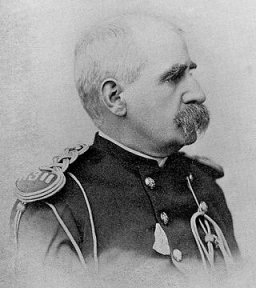
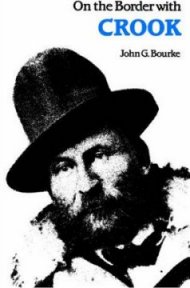
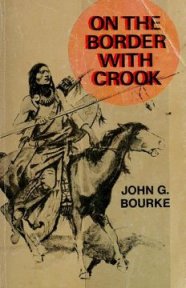
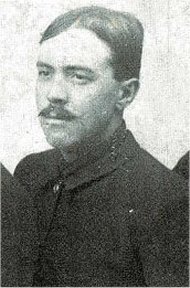
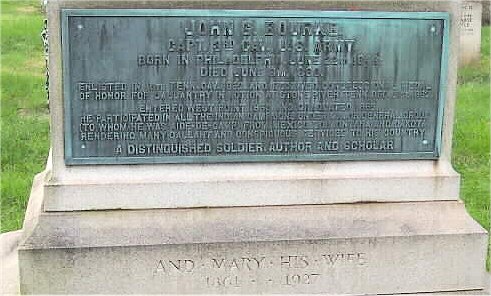
![]()
![]()

![]()